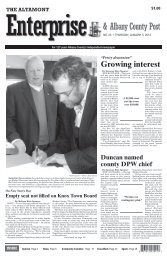2 <strong>The</strong> <strong>Altamont</strong> <strong>Enterprise</strong> – Thursday, May 17, 2012EditorialWithout flexibility, the eagle cannot fly<strong>The</strong> outcry could be heard locally and from coast to coast. Rural voicesraised objections, loud and clear, to plans by the United States <strong>Post</strong>alService to close offices as the service struggled to remain solvent.Last week, the USPS made a welcome announcement: Rather than closingoffices outright, hours will be reduced at many rural post offices. That’s goodnews for Guilderland Center and Clarksville, which were slated for closure,but other area post offices will now see reduced hours as well. We’re runninga list this week of the proposed changes for all of our local offices.In giving background for its new plan last Wednesday, the postal servicestated that its announcement last July — nearly 3,700 post offices wouldbe studied for possible closure — was one strategy in the wake of continueddecline in the volume of mail, ongoing financial challenges, and changingcustomer behavior. <strong>The</strong> postal service claimed that, as population shiftedto more urban and suburban settings, an outdated network of retail officesremained where few people live, work, or shop.In our area, at least, this is not true. <strong>The</strong> post offices remained at theheart of their communities.Last May, we wrote of the uprising in Guilderland Center as residentswho referred to the post office as the hub of their small community, expresseddismay at having to drive four miles to <strong>Altamont</strong> to get and sendmail. “Taking away the post office is taking away our identity,” said AllenJager, pastor of the Helderberg Reformed Church in Guilderland Center.<strong>The</strong> acting postmaster said that the elderly were kept track of throughthe post office; if someone doesn’t show up for mail for a day or two, thatperson is checked on.In New Scotland’s rural hamlet of Clarksville, residents expressed similarconcerns at having to drive to the post office in Feura Bush five miles away.Many with small businesses said they relied on having the post office inthe hamlet.One of them, lawyer Peter Henner, filed a petition last September on behalfof himself and more than 30 people and six businesses, arguing that thepostal service did not consider the actual fiscal impact of the proposed closing.<strong>The</strong> following month, the <strong>Albany</strong> <strong>County</strong> Sheriff’s Office filed a noticeof intervention to oppose the closure, since it plans to move to the vacantelementary school in Clarksville and said it would need a functioning postoffice for certified letters, packages, and for mailing bulky materials.<strong>The</strong> commission concluded that the postal service had not “adequatelyconsidered the effect of the post office closing on the community.”Clarksville was not alone in its objections. <strong>The</strong> commission got 100 appealsfor post office closures in 2011 and 100 more in the first quarter ofthe 2012 fiscal year, according to its annual report to Congress. In 2010, ithad gotten only six appeals.Last summer, the postal service had changed its process forevaluating office closures to a “top-down review,” the <strong>Albany</strong>district’s spokeswoman, Margaret Pepe, told us at the time.“It was done nationally,” she said of the change, explaining,“with everything going on in the <strong>Post</strong> Office…we know we’regoing to run out of money.”Customer retail visits, according to the postal service, havedropped by 27 percent from 2005 to 2011.This is because 61percent of customers use traditional post offices while 39percent used expanded access — accessing services online,from other providers or kiosks, or by fax or phone. <strong>The</strong> postalservice says that 88 percent of rural post offices are losingmoney.If cutting back hours will allow the small offices to remainopen, we’re for the change.<strong>The</strong> postal service’s survey of rural customers showed, when they wereoffered four choices, the majority, 54 percent, prefer maintaining current officeswhile modifying window hours. Twenty percent preferred establishing avillage post office; 15 percent favored merging with a nearby post office; and11 percent chose using rural carriers to deliver to roadside mailboxes.<strong>The</strong> rural post offices will stay open, the postal service has promised, unlessa community has a strong alternative preference. <strong>The</strong> new approach isslated to be completed by September 2014.This is making the best of a bad situation. Unlike other services of federalgovernment, the postal service has to pay for itself. It is a governmentbusinesshybrid, confined by legislation in the way its private-sector competitorsare not.Although its roots go back to 1775, set up in Philadelphia by BenjaminFranklin, the <strong>Post</strong> Office Department was created as part of the UnitedStates Cabinet in 1792. But in 1971, under the <strong>Post</strong>al Reorganization Act,the U.S. <strong>Post</strong>al Service was set up as an independent establishment of theexecutive branch, making it self-sufficient, funded almost entirely by postagerather than taxpayer dollars. It is obligated to serve all Americans atuniform price and quality, regardless of geography.At the same time that electronic mail has undercut the use of traditionalpostal services, the USPS has been stymied from progressing in the digitalage by the government itself. According to a Government AccountabilityOffice report that is nearly a dozen years old, from September 2000, thepostal service identified an electronic mailbox, a concept then in the earlydevelopment stage, that could link electronic and physical addresses, asan infrastructure initiative. <strong>The</strong> service also introduced an eBillPay initiative,an electronic bill payment service, in April 2000. <strong>The</strong> next month,it introduced the <strong>Post</strong>eCS initiative, an Internet-based global documentdelivery system.Congress denied the postal service’s request to start these electronic initiatives,saying it should refrain from direct competition with private firms.Private companies, as we’ve noted before, have taken on similar projectsand prospered.Where does that leave the American people?Meanwhile, unlike other federal agencies, the postal service is requiredto prefund retiree health benefits, totaling about $5.5 billion; Congress hasnot granted postal service requests to alter the payment schedule.In the long run, the postal service needs more flexibility if it is to surviveand prosper. It is a service that not only provides a needed center to ruralcommunities but binds a country together.Congress denied the postal service’s requestto start these electronic initiatives,saying it should refrain from direct competition with private firms.
<strong>The</strong> <strong>Altamont</strong> <strong>Enterprise</strong> – Thursday, May 17, 2012 3<strong>The</strong> <strong>Enterprise</strong> opinion pages are an open forum for our community.We encourage readers to express their thoughts about issues that appear inthis newpaper or affect the community. Letters should be brief (with anoutside limit of 1,000 words) and must include the writer’s address, name,Back In Time. . .and phone number for verification. <strong>The</strong> editors may reject letters that havebeen printed elsewhere. Letters concerning elections will be cut off1912 100 Years Ago 2012one issue before the election at theeditor’s discretion. No unsigned letters.<strong>Altamont</strong> <strong>Enterprise</strong> May 17, 1912To the editorDeadline for letters is Tuesday at noon.<strong>The</strong>re is nothing to celebrate at nursing homesTo the Editor:I have a comment about celebratingnursing homes. [Inresponse to a May 10, 2012 letterwritten by Richard J. Herrick,president of the New York StateHealth Facilities Association,about National Nursing HomeWeek; this year’s theme is “Celebratethe Journey.”]If you ever had any dealingswith patients, you know there isnothing to celebrate. I visit everyday, but most of the patients areleft alone all day.Most of the aides do not visitwith the patients at all. If theTo the Editor:I was surprised to note that aheading and the lead sentenceof an article written on a noneditorialpage in the May 3, 2012issue of your newspaper [“GCSDresponds to Obamacare” online atwww.<strong>Altamont</strong><strong>Enterprise</strong>.com]used the word “Obamacare” whendescribing the country’s healthcare national legislation.That term is definitely a familiarone, coined and used by onepolitical party in a derogatoryway, to describe the health carepackage.To the Editor:Teaching these days feels like amerry-go-round that doesn’t end.<strong>The</strong>re is so much that is out ofour control.Teachers are concerned thatthe curriculum is only going tobe test-taking practice and teachingconcepts they don’t value buthave to teachbecause theywill be evaluatedon the testresults.T e a c h e r sneed a way toassess students.Teachers shouldbe the ones todevelop thesea s s e s s m e n t sand not corporations.If test-makersbecome thelatest local assessment,localcurriculum thathas been carefullydeveloped is going to bethrown out the window and theones to suffer will be the children.This is concerning to meas a teacher and as a mother ofthree children.According to the new AnnualProfessional Performance Review(APPR), there are severaloptions that can be used to assessstudent growth for localassessments. One option is touse the New York State Englishlanguage arts and math test results.School districts can look atdifferent domains and determinehow a student has shown or notshown growth.Given the fiasco of the recentstate tests, how fair is it to evaluatea child’s growth based on aflawed test?Another option is to use athird-party assessment off of alist from the New York StateEducation website. <strong>The</strong>se thirdpartyassessments are very costlypatient needs help with something,they are told to wait andmaybe within the hour the aidewill help them.Most of the aides have littleor no compassion for the patients.<strong>The</strong>y are there to do ajob; I know sometimes not a verypleasant one. <strong>The</strong>y chose theirprofession and they should takepride in it.Nursing homes take every centyou worked your whole life for.At over $10,000 a month, I feelpatients should get better care.I have had dealings with anursing home for seven monthsQuality of newspaper suffers with red-flag wordsIn my opinion, the quality ofyour newspaper, which usuallyadheres to such high standards,becomes diminished when youuse “red flag words” in a noneditorialsection of the paper— especially in a presidentialelection year.Anita BehnGuilderlandEditor’s note: “Obamacare”was, indeed, coined by Republicans,similar to Hillary Clinton’sfailed “Hillarycare,” to deride theHand in hand with instructionteachers need to take the lead on local assessmentsand do not match instructionalprograms and beliefs of severaldistricts. Instruction cannot beruled solely by state assessmentsor third-party assessments.<strong>The</strong>re are other options to usingthe state tests in a different wayand third-party assessments. Oneoption is for districts to developTeachers can’t give upon the integrity of theprograms they teach.their own local assessments.Teachers need to take the leadon local assessments. It must berigorous and comparable acrossclassrooms and schools and mustbe approved by the district superintendent.<strong>The</strong>re are teacherswilling to do this work. <strong>The</strong>re istraining as well.<strong>The</strong>re are programs like LinkItand Acuity that can help districtsalign what they already do to thenew Common Core requirements,which is one of the state’s requirementsof a local assessment.Many districts already havewonderful district-wide assessments.Districts have workedextremely hard at developingassessments that demonstratea student’s strengths and weaknesses.<strong>The</strong>se assessments help informteachers on what they need toinstruct. <strong>The</strong>y help teachers learnabout each student as a learner.<strong>The</strong>y help teachers know how toand the service hasn’t gotten anybetter. When you have to go to thebathroom you shouldn’t have tobe told, “you have to wait.”I personally sat with a patientwho had to wait 45 minutes to goto the bathroom. I couldn’t helpbecause they told me I wasn’tqualified.<strong>The</strong> words the patients hate tohear — “You have to wait” and“I’ll be right back” — are nothingto celebrate.Pauline LawyerEast BernePatient Protection and AffordableCare Act. But in March, PresidentBarack Obama and his staff embracedthe term. “You want to callit Obamacare — that’s ok becauseI do care,” said the president. Partof his re-election strategy now isto use the popular term in a waythat stresses the positive aspectsof the law.We used the term because itis the most recognizable wayto name the federal health-carereform.group students for differentiatedinstruction to reach curriculumgoals.In this age of data-driven results,we can’t compromise whatwe believe is best practice. Mostimportantly, teachers can’t giveup on the children they teach andtake away time from authenticreading andwriting experiences.T e a c h e r scan’t give up onthe integrity ofthe programsthey teach.School districtsand teachersneed to haveassessmentsthat demonstratestudentgrowth and informclassroominstruction.<strong>The</strong> assessme n t a n di n s t r u c t i o nshould go hand in hand. <strong>The</strong> assessmentsshould assess what wevalue and believe are the skillsnecessary to be successful inthe 21st Century. Districts mustkeep the curriculum that helpstudents become strong life-longlearners.It’s time for teachers andadministrators to sit down andtalk about the assessments thatare already being used that helpstudents learn and help informclassroom instruction. <strong>The</strong> costsavings, in my opinion, is theicing on the cake.<strong>The</strong> most important thing is topreserve what we value and stillbe able to instruct in a way weknow is good for children.Tara Molloy-GrockiGuilderlandEditor’s note: Tara Molloy-Grocki is a teacher at GuilderlandElementary School.Magpies, Rooks and Apes Can’t Get Past the Number Four:<strong>The</strong>re are human beings, such as inhabitants of the MurrayIslands, in the strait of Torres, that cannot count further thantwo. But, most surprising still, most animals possess calculatingabilities, and several have a distinct appreciation ofnumbers. In certain mines of Hainault the horses are so usedto traversing the same road thirty times that after their lastround they go to the stable of their own accord and refuse totake another step. Montaigne says that the oxen employed inthe royal gardens of Susa for turning the wheels to which thewater pails were attached absolutely refused to make morethan a hundred rounds, which constituted their daily task.A close observer has definitely established the fact thatmagpies and rooks cannot count further than four. A rooknever returns to its nest until it is quite satisfied that thereis no danger near. When four hunters or less departed in successionfrom a nearby log cabin the rook would return to itsnest after the last had gone out of sight. But whenever therewere more the bird lost count and returned to its nest evenwhile some were still in the hut.Similarly apes do not count further than four, and the Boersof the Trans vaal when they want to hunt these animals hidein numbers exceeding four. Four depart in succession in sucha manner as to be noticed by the apes who then come forthand are easily captured. –– Chicago News.****First Printer’s Devil: Aldus Manutius, who in 1488 set uphis office in Venice, has long been famous as the first of thepublishers of the famous Aldine classics, which today are sohighly prized by book collectors. He was the author of a Latingrammar, a Greek dictionary and a treatise on the metricalmethods of the poet Horace and originated the form of typeknown by us as Italic and by German printers as “cursive”type.He is also said to be responsible for the name of “printer’sdevil,” almost worldwide in its application to the youngest boyin the office. A young negro slave employed in his office who wasso very black and dirty that his natural ugliness had become analmost fiendish expression became feared and known all overVenice as “the little black devil,” and Manutius at last realizedthat the boy and himself had dangerously awakened thesuperstitious fears and dislike of the more ignorant Venetians.He accordingly formally exhibited him during a whole day onthe public streets and had the criers make this proclamationthroughout the city:“I, Aldus Manutius. Printer to the holy church and the doge,have this day made public exposure of the printer’s devil. Allwho think he is not flesh and blood may come and prick him.”–– Charles Winslow Hall in National Magazine.Published continuously since July 26, 1884“We seek the truth and print it”JAMES E. GARDNERPublisherMELISSA HALE-SPENCEREditorNEWS OFFICE — 861-5005 or 861-5008..................BUSINESS OFFICE — 861-6641Staff Writers......................................................... Jo E. Prout, Zachary simeone,JORDAN MICHAEL, ANNE HAYDEN, TYLER MURPHYIllustrator.................................................................................................... FOREST BYRDAdvertising Director......................................................CHERIE LUSSIER — 861-8179Advertising Representative................................... JACQUELINE THORP — 861-5893Office Manager..................................................................................WANDA GARDNERPhotographer.........................................................................................MICHAEL KOFFProduction................................ JAMES E. GARDNER JR., BARBARA DEGAETANO,................................ELLEN SCHREIBSTEIN, RICH MENDOZA, CHRISTINE EKSTROM<strong>The</strong> <strong>Enterprise</strong> is the newspaper of record for Guilderland, New Scotland, Berne, Knox,Westerlo, and Rensselaerville. Our mission is to find the truth, report it fairly, and providea forum for the open exchange of ideas on issues important to our community.PUBLISHED THURSDAYS at 123 Maple Ave., <strong>Altamont</strong>, NY 12009. Periodicalpostage paid at <strong>Altamont</strong>, NY. <strong>Post</strong>master: Send address changes to<strong>The</strong> <strong>Altamont</strong> <strong>Enterprise</strong>, PO Box 654, <strong>Altamont</strong>, NY 12009. USPS 692-580,ISSN 0890-6025.FAX: 861-5105. E-MAIL: info@altamontenterprise.comWEBSITE: www.altamontenterprise.comOFFICE HOURS: 9 a.m. to 5 p.m., Monday through Friday.SUBSCRIPTION RATES: For <strong>Albany</strong> <strong>County</strong> residents, one year, $33; sixmonths, $26. For out-of-county subscribers, one year, $37; six months, $31.<strong>Post</strong>al charges incurred by a subscriber’s failure to notify the newspaper ofan address change will be billed to the subscriber upon renewal. No refundson subscriptions. Single copy: $1.00.ADVERTISEMENT RATES available upon request. <strong>The</strong> publisher reservesthe right to reject advertising at any time for any reason. Liability for errorsin advertisements will, at the publisher’s discretion, be limited to the valueof the ad only.NEWS DEADLINES: For correspondents’ columns, Monday before publication.For all other contributions, Tuesday before publication.CORRECTIONS: <strong>The</strong> <strong>Enterprise</strong> will correct errors and clarify misunderstandingsin news stories when brought to the attention of the editor, phone861-5005.VIEWPOINTS expressed by staff members, contributing writers, and correspondentsdo not necessarily reflect those of the ownership of <strong>The</strong> <strong>Enterprise</strong>.QUESTIONS and COMMENTS concerning the content of this newspapershould be directed to the editor by calling 861-5005 or in the form of a letterto the editor.WEDDING AND ENGAGEMENT ANNOUNCEMENTS will be printed freeof charge. A $20 fee will be charged for announcements with a photograph.PHOTOGRAPHS will be printed with announcements about students fora $30 minimum fee. <strong>The</strong>re is no charge to print announcements withoutphotographs.
- Page 1: The AltamontEnterprise& Albany Coun
- Page 5 and 6: The Altamont Enterprise - Thursday,
- Page 7 and 8: The Altamont Enterprise - Thursday,
- Page 9 and 10: The Altamont Enterprise - Thursday,
- Page 11 and 12: The Altamont Enterprise - Thursday,
- Page 13 and 14: The Altamont Enterprise - Thursday,
- Page 15 and 16: The Altamont Enterprise - Thursday,
- Page 17 and 18: The Altamont Enterprise 2012Spring
- Page 19 and 20: The Altamont Enterprise - Thursday,
- Page 21 and 22: The Altamont Enterprise - Thursday,
- Page 23 and 24: The Altamont Enterprise - Thursday,
- Page 25 and 26: The Altamont Enterprise - Thursday,
- Page 27 and 28: The Altamont Enterprise - Thursday,
- Page 29 and 30: The Altamont Enterprise - Thursday,
- Page 31 and 32: The Altamont Enterprise - Thursday,
- Page 33 and 34: The Altamont Enterprise - Thursday,
- Page 35 and 36: The Altamont Enterprise - Thursday,
- Page 37 and 38: The Altamont Enterprise - Thursday,
- Page 39 and 40: The Altamont Enterprise - Thursday,
















